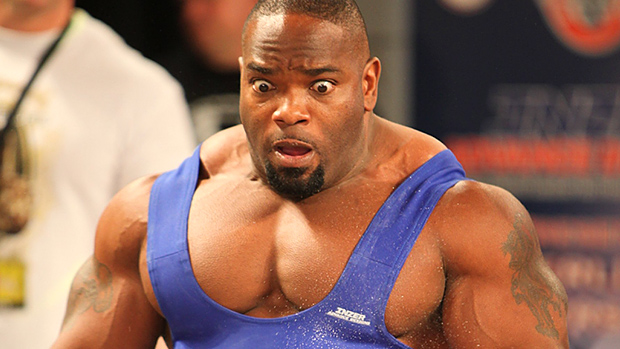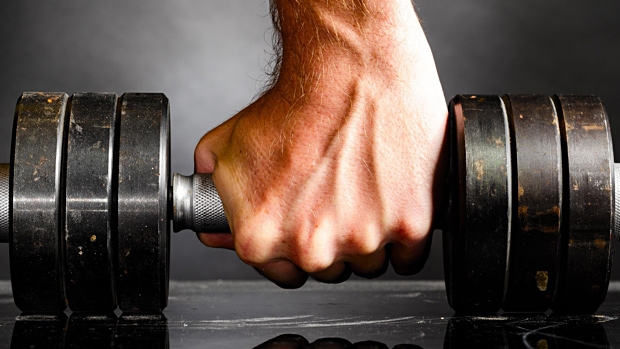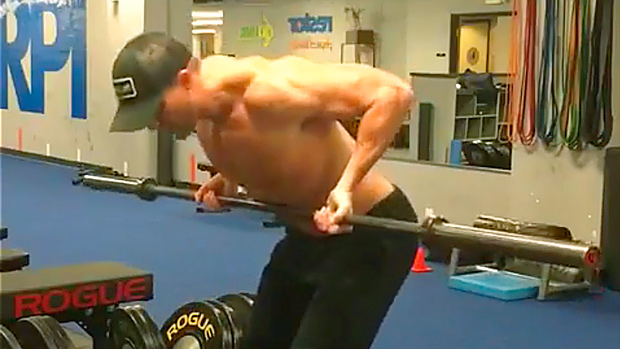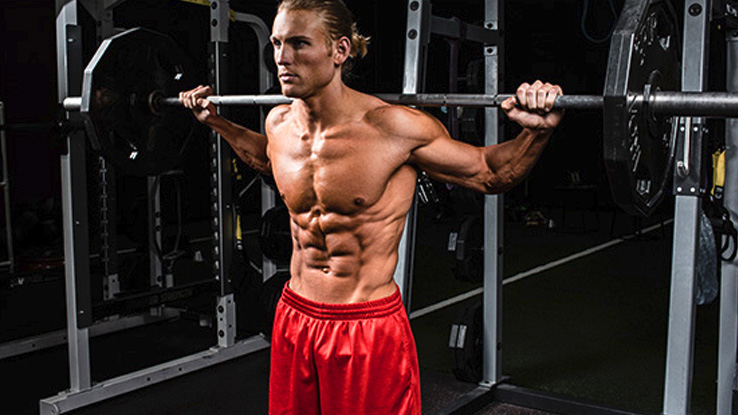Last time around, I hit you up with an article called Powerlifting for Bodybuilders where I listed all the things bodybuilders can learn from powerlifters. In this installment, I'm going to discuss how powerlifters can benefit from certain aspects of bodybuilding.
Most powerlifters view bodybuilders as evil incarnate. Bodybuilders' goals are sub-standard and revolve around physique changes with minimal focus on improving real-world strength. A typical slam is that bodybuilders are "all show and no go."
Hopefully, I'll disprove some of these myths and show my fellow powerlifters just a few of the benefits that can be learned from our bodybuilding brethren.

A lot of powerlifters subscribe to the notion that since they powerlift, they can eat whatever the hell they want. While I'm all for a frosty beer after a meet, a lot of powerlifters take it to the extreme. Drinking in excess, following the "see food" diet, and basically giving no regard to nutrition is a surefire way to stall your progress.
Simply put, just because you're a powerlifter you don't have a license to go out and get fat. Bodybuilders know that proper nutrition not only fuels their workouts, but helps them recover properly afterwards. Why would you want to go out and set PRs on all your lifts, only to go home and eat leftover pizza and beer from the fridge? Unfortunately, a lot of powerlifters treat their cars better than their own bodies.
As powerlifters, our goals should be to maximize muscle tissue and promote positive changes in body composition. While it's not always going to be the case, compare two lifters competing in the 220# weight class; one is sitting at a lean 10% body fat, while the other is a "chunky" 18%. All things being equal, which one will win? If you answer correctly, give yourself a gold star for the day.
Granted, it won't always come down to who has the better body composition. But, simply put, the leaner and more muscular you are in a given weight class, the more muscle cross-sectional area (CSA) you have to develop tension and move more weight.
If you read this and realize you don't have the first clue about how to eat properly, I highly suggest reading everything possible here at T-Nation by nutrition experts such as Dr. John Berardi, Dr. Lonnie Lowery, and David Barr.
Any supplement company worth its salt will tell you that anyone supplementing their diet without first addressing proper nutrition is missing the boat. We discussed the benefits of proper nutrition above, but what can supplementation do for a strength/power athlete such as yourself?
Once we train hard and eat properly, supplementation can take our performance to the next level. Our first and most basic goal is to meet our daily protein needs. This can be accomplished with supplements such as Metabolic Drive® Protein and Finibar™ Competition Bar.
In fact, these could actually be mentioned with proper eating habits. I don't know about you, but I simply don't have the appetite to eat six or seven protein-heavy meals per day! These two supplements help me meet my protein needs without feeling full or bloated.
Next, we need to consider pre/peri/post-workout supplementation. Plazma™ and Mag-10® are the industry standards, and again could be included in our discussion of proper eating habits. It's a "supplement," but its role in jump-starting the recovery process can't be overlooked.
Fast-acting whey protein hydrolysate coupled with BCAA's, maltodextrin and glucose can maximize and kick-start our recovery after a grueling training session. If you haven't read his article yet, I highly encourage you to read Barr's Top 10 Post Workout Nutrition Myths article, as well as JB's Solving the Post-Workout Puzzle.
Taking it a step further, the benefits of supplements such as ZMA® and Brain Candy® can't be overlooked when discussing a holistic supplementation program for strength/power athletes. Powerlifting is much harder on the nervous system when compared to the bodybuilding style training, so we must strive to improve neural recovery between workouts. Power Drive can and should be utilized for its role in giving the nervous system the raw materials it needs to regenerate itself.
As well, you can't talk about proper recovery and not discuss sleep. ZMA can increase natural levels of anabolic hormones, while simultaneously improving the quality of your sleep. If you haven't given it a shot, you owe it to yourself to try it out and see what a great night's sleep can do for your training!
Finally, powerlifters put a beating on their joints in each and every training session. EPA/DHA (fish oil) has been noted in scientific literature for its role in decreasing inflammation, while glucosamine and chondroitin have been used for their roles in sparing, and possibly even regenerating, articular cartilage. I often promote usage of both of these supplements to anyone who's serious about their weight training.
Just as bodybuilders can benefit from low-rep training, powerlifters can benefit from high-rep training. High rep training (especially on assistance exercises), increases strength in the tendons and ligaments.
I'd go so far as to say that performing high-rep, hypertrophy style work for muscle groups such as the biceps, pectorals, and quadriceps could lead to a significant reduction in the incidence of powerlifting related injuries that we see most often (torn biceps, torn pecs, and torn patella tendons).

Beyond the benefits of being injury-free and having strong connective tissue, high rep training will also help develop hypertrophy. I know, this isn't rocket science, but let's go back to the previous example for a second. Let's take our same two lifters, with the leaner guy also having massive levels of hypertrophy in the upper back, triceps, and chest, while the second lifter is by no means small, but not nearly as well developed in these muscles.
All things being equal, which one will press more? Powerlifting performance is dictated by individual leverages, proper technique, neuromuscular efficiency, and a host of other factors. However, when we make things really simple, a bigger muscle has the capability of producing more tension than a smaller one.
Many strength coaches advocate periods of high-rep, acclimation/accumulation style workouts, with periods of lower rep, strength/intensity based workouts. The goal is to build muscle tissue in the first phase, and then improving neural recruitment in the second phase. While you may not necessarily choose to alternate, throwing some high rep work into your program should leave you pleasantly surprised with your gains in muscle mass and connective tissue strength.
I may get flamed for this one, but I really feel that powerlifters that aren't doing some single-leg work in their programs are setting themselves up for future injury at some point in their careers. Bodybuilders know the many benefits of single-leg training, and hopefully powerlifters will take heed and follow suit.
Over the course of a career, we all get nicked up and have small injuries that we can train through. While it may be nothing serious, our bodies are much more conscious of injuries and will typically find ways to train around them. In essence, our bodies are very adept at compensating.
Say for instance you pull a groin muscle while training. You can train, but every time you squat you can "feel" that things aren't right. Your body knows this as well, and it starts to compensate by shifting some of the weight to the opposite side. Next thing you know, not only do you have a flawed motor engram while squatting, but you're also developing a muscle imbalance.
This muscle imbalance causes tightness in the "stronger" limb, which leads to a restricted ROM (range of motion.) Eventually, something has got to give, and you typically end up with a more serious injury than the one you started with. I can't tell you the number of powerlifters I see that have imbalances in either strength or flexibility while squatting and deadlifting.
Single leg work allows us to correct muscle imbalances, along with giving us some variety in our training. I'd never give up the basic strength and muscle building exercises such as squats, deadlifts, good mornings, RDL's and the like, but adding in some single leg work can kill many birds with one stone. Single leg exercises can develop strength, develop hypertrophy and connective tissue when used with higher reps, and can eliminate side-to-side imbalances.
If you'd like to add some single-leg exercises into your program, check out my Single Leg Supplements article for a plethora of different exercises and variations.

Simply getting in the gym and trying out some different exercises can do wonders for not only your strength, but your motivation levels to boot! I think sometimes bodybuilders get a little overboard with regards to changing their exercises too frequently, but a lot of powerlifters do the opposite. They never change their exercises!
If you've been doing the same max effort exercises or the same assistance exercises for an extended period of time, change things up. You've probably already gotten the maximal benefit from the exercise, and your body needs something new to adapt to.
Another added benefit of changing exercises is that it can often make training (gasp!) fun! I typically find that when I add in some new exercises to my training or that of my athletes, not only is training more fun, but you're typically making some serious progress as well.
It's a chicken or the egg dilemma. Are you making progress because you're having fun with your training, or are you having fun because you're making progress? I don't really care as long as it leads to the result I want: a bigger total!
I know, I've done it now! I mentioned the word "cardio" in a powerlifting article!
Before we go on, let me give you a quick, easy definition. "Cardio" is simply any from of exercise that challenges the heart and lungs. When most people think of cardio, they think of hamster style workouts on a treadmill; this doesn't have to be the case. Remember, anything that challenges the heart and lungs is cardio. Examples could be forms of weighted cardio such as sledgehammer training, pushing a wheelbarrow, flipping tires, farmers walks, etc.
I'm sure some of you are thinking, "What can cardio do for me? I'm no bodybuilder!" Carl Valle and I discussed the benefits of cardio training for strength and power athletes in our Superior Circuit article series, as did Eric Cressey in his Cardio Confusion article. In addition to giving you rationale for cardio training, both of these pieces also give you fun alternatives so you can quit your intense sessions on the recumbent bike.
Here's a quick synopsis, just in case you don't want to read the articles: low-intensity cardio can speed recovery, improve body composition, and most importantly improve your overall health. Come on, I want you to live a little longer!
I love the progressive attitude that powerlifters have toward their training. We're always striving to figure out new and improved ways to increase our lifts. I think some aspects of bodybuilding can significantly improve not only our totals on the platform, but our overall health as well.
Until next time, get your ass in the gym and have a great workout!





